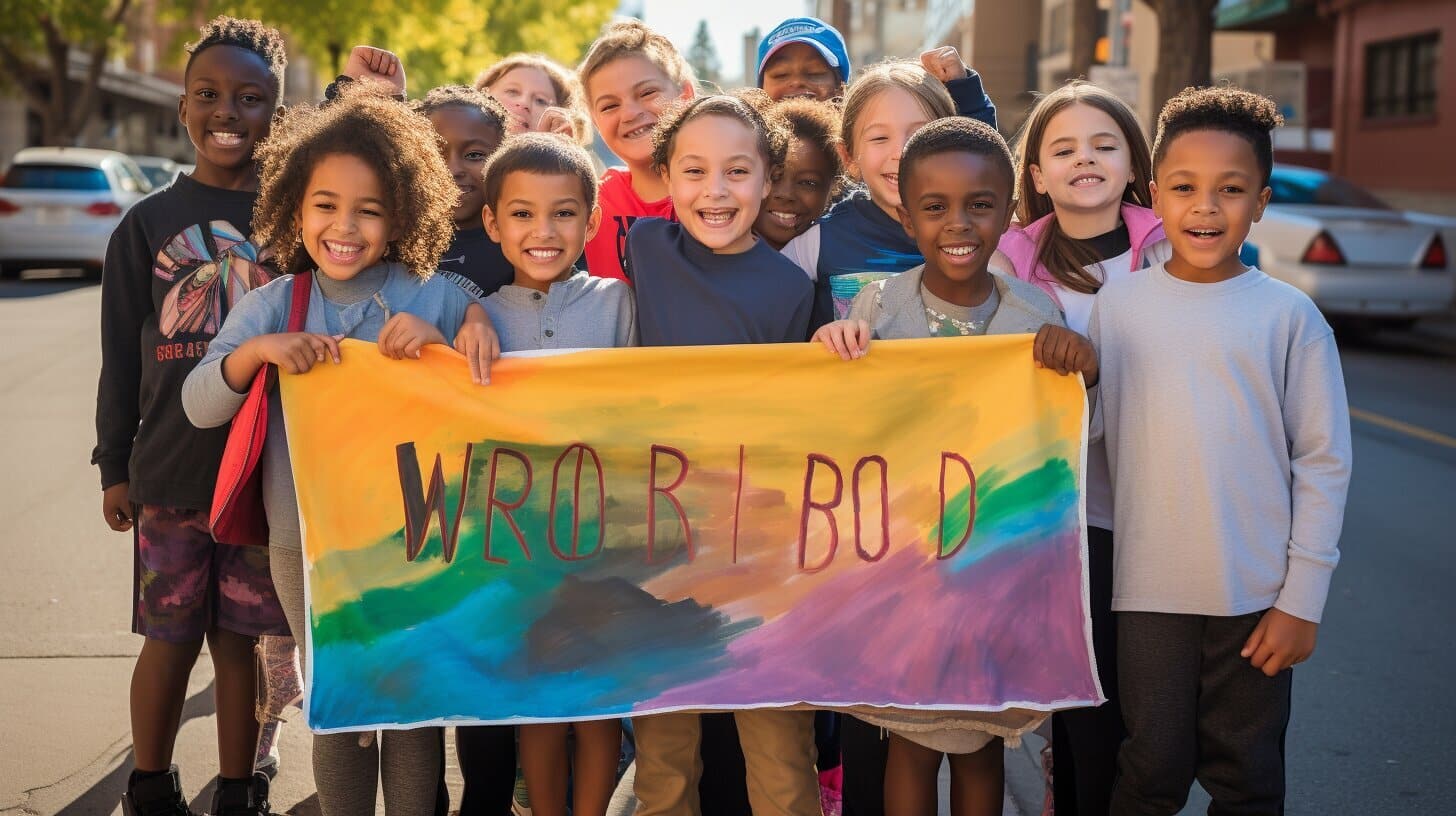As a parent, you want your child to grow up to be a kind, empathetic, and respectful person. One way to instill these values is by teaching them about humility. Humility is the ability to recognize your own limitations, be modest, and respect others. By teaching humility to your child, you can help them build stronger relationships, develop empathy, and foster a growth mindset.
In this guide, you’ll learn how to explain humility to a child in a way they can understand. We’ll discuss why humility is important for children, provide examples of humble behaviors, and give you practical advice on how to incorporate humility into your child’s daily life. By the end of this article, you’ll have the tools you need to help your child cultivate a humble and respectful attitude.
Key Takeaways:
- Humility is the ability to recognize your own limitations, be modest, and respect others.
- Teaching humility to your child can help them build stronger relationships, develop empathy, and foster a growth mindset.
- In this guide, you’ll learn practical advice on how to incorporate humility into your child’s daily life.
What is Humility?
Humility is the quality of being humble, modest, and respectful towards oneself and others. It means recognizing one’s limitations, admitting mistakes, and valuing the opinions and contributions of others. Humility is an important quality for children to learn because it helps them develop strong relationships, promotes empathy, and encourages a growth mindset.
To explain humility in a child-friendly way, you can use examples of humble behaviors, such as being kind to others, helping without seeking recognition, and acknowledging mistakes. You can also use everyday situations to illustrate humility, like when your child shares a toy with a friend or admits to breaking a vase.
Remember, teaching kids about humility can be challenging because it is a complex concept. But with patience, consistency, and age-appropriate language, you can help your child understand the importance of humility and how to practice it in their daily lives.

Why is Humility Important for Children?
Teaching humility to children is essential for their personal growth and development. Humility can help children build better relationships, exhibit empathy, and foster a growth mindset. When children are humble, they tend to be more open to learning from others and accepting constructive feedback, which can help them improve their skills and knowledge.
Humility also helps children develop a strong sense of self-awareness and self-worth. When children understand that they are not the center of the universe and that everyone has unique talents and abilities, they are more likely to appreciate their own strengths without feeling the need to compare themselves to others.
Moreover, children who learn the value of humility are more likely to be kind and compassionate towards others. They are less likely to engage in bullying behavior and more likely to embrace diversity and inclusivity. By fostering humility in children, parents can help create a kinder, more empathetic society.

Additionally, humility can help children develop a growth mindset. When children understand that everyone makes mistakes, they are more likely to embrace challenges and face them head-on. Rather than seeing setbacks as failures, they will see them as opportunities to learn and grow.
In short, teaching humility to children is not only important for their personal growth and development, but it also contributes to creating a kinder, more empathetic, and inclusive society.
Teaching Humility Through Stories and Examples
Children learn best through stories and examples. By sharing anecdotes that highlight the importance of humility, you can help your child understand the concept in a relatable and engaging way. Here are a few ideas:
| Story/Example | Lesson Taught |
|---|---|
| The Ant and the Grasshopper | Being prepared and hard-working pays off in the long run. |
| The Tortoise and the Hare | Overconfidence can be a weakness, and persistence is key to success. |
| Volunteering at a homeless shelter | Helping others without expecting anything in return is a humble and compassionate act. |
You can also introduce your child to humble role models, such as Gandhi, Mother Teresa, or Malala Yousafzai. By learning about these individuals and their accomplishments, your child can see firsthand how humility can lead to greatness.

“True humility is not thinking less of yourself, it’s thinking of yourself less.” – C.S. Lewis
By incorporating stories and examples into your conversations with your child, you can help instill the value of humility in their daily life.
Encouraging Gratitude and Appreciation
Gratitude and appreciation go hand in hand with humility. When we express gratitude, we acknowledge the contributions of others and the good things in our lives. Encouraging children to practice gratitude and appreciation can help them develop a humble mindset and foster positive relationships with others.
There are many ways to cultivate gratitude and appreciation in children’s daily lives. One idea is to start a gratitude journal with your child. Each day, write down something that you are grateful for and encourage your child to do the same. This can help children focus on the positive things in their lives and develop a sense of appreciation for the world around them.
Another way to promote gratitude is to encourage children to say “Thank you” more often. Encourage them to express appreciation when someone does something nice for them, or when they receive a gift. This can help children develop a habit of recognizing and acknowledging the contributions of others, which is an important aspect of humility.
Finally, it’s important to lead by example when it comes to gratitude and appreciation. Show your child how to express appreciation and gratitude towards others by thanking people for their help and showing appreciation for the little things in life. When children see their parents demonstrating these behaviors, they are more likely to adopt them as well.

Gratitude makes sense of our past, brings peace for today, and creates a vision for tomorrow.” – Melody Beattie
Promoting Empathy and Understanding
Humility goes hand in hand with empathy and understanding. When you are humble, you are more open to other people’s experiences and perspectives. Teaching your child to be empathetic and understanding can help them build better relationships and become more compassionate individuals.
One way to promote empathy in children is to encourage active listening. Teach your child to listen carefully to what others are saying and to ask questions to clarify their understanding. Encourage them to put themselves in other people’s shoes and imagine how they would feel in the same situation.
You can also promote empathy by modeling it yourself. Show your child how to be considerate and understanding towards others. When you encounter someone who is going through a difficult time, talk to your child about how they might be feeling and what you can do to help.
When you show deep empathy toward others, their defensive energy goes down, and positive energy replaces it. That’s when you can get more creative in solving problems.” – Stephen Covey
Another way to encourage empathy and understanding is by exposing your child to diverse cultures and backgrounds. This can help broaden their perspective and make them more accepting of people who are different from themselves. Read books, watch movies, and explore different traditions with your child to help them learn about the world around them.
Overall, promoting empathy and understanding in children is a vital component of instilling humility. By teaching your child to be open to others’ experiences and perspectives, you are helping them to become more compassionate, kind, and humble individuals.

Setting Realistic Expectations
Teaching your child about humility includes guiding them to set realistic expectations for themselves and others. It’s natural for children to compare themselves to others, but this can lead to either arrogance or low self-esteem. Encouraging your child to focus on their own progress and accomplishments, rather than comparing themselves to others, can promote humility and healthy self-esteem.
For example, if your child is struggling in school, instead of comparing themselves to classmates who may be doing better, encourage them to focus on their own improvement. Celebrate their progress and effort, rather than just their grades. This can help your child develop a growth mindset and a sense of humility.
Additionally, it’s important to avoid placing unrealistic expectations on your child or pushing them too hard. Instead, focus on creating a supportive and positive environment where your child feels safe to make mistakes and learn from them. This can help promote humility and a healthy sense of self-improvement.

Acknowledging and Admitting Mistakes
Admitting mistakes and taking responsibility for them is a crucial aspect of humility. Encourage your child to learn from their mistakes and apologize when necessary. Explain that owning up to mistakes is a sign of strength and self-awareness.
It’s important to create a safe space where your child feels comfortable admitting their mistakes without fear of harsh criticism or punishment. This will help build their confidence and encourage them to be honest and accountable.
Remember to lead by example and admit your own mistakes when you make them. This will show your child that everyone makes mistakes and that it’s important to take responsibility for them.

Practicing Humility in Everyday Life
To help your child develop humility, it’s essential to encourage them to practice it in their daily life. Here are some practical ways to instill humility in your child:
- Encourage acts of kindness: Encourage your child to perform small acts of kindness without seeking recognition or reward. Simple acts like holding the door open for someone, sharing their toys, or helping a neighbor can go a long way in building humility.
- Practice gratitude: Teach your child to be grateful for what they have and to appreciate the people and things in their life. Encourage them to express gratitude by saying thank you or by writing thank-you notes.
- Avoid comparing: Help your child understand that everyone is unique and special in their way. Comparing themselves to others can lead to arrogance or low self-esteem. Teach them to appreciate their own qualities and strengths instead.
- Admit mistakes: Encourage your child to own up to their mistakes and take responsibility for their actions. Help them understand that making mistakes is a part of learning and growing, and admitting mistakes is a sign of humility and strength.
- Show empathy: Help your child understand other people’s feelings and perspectives by encouraging them to listen and consider them. Teach them that showing empathy and understanding towards others is a sign of humility and respect.
- Lead by example: Finally, remember that your child learns from observing your behavior and attitude. Model humility in your own actions and interactions, and your child is likely to follow your lead.
By incorporating these ideas into your child’s daily life, you can help them develop humility and become a kind, respectful, and empathetic person.

Leading by Example
As a parent, you play a crucial role in teaching your child about humility through your own behavior and attitudes. Children learn by observing and modeling the actions of the adults in their lives. Therefore, it’s important to lead by example and demonstrate humility in your interactions with others.
Show your child how to be humble and respectful towards others by listening to them, acknowledging their opinions, and admitting your own mistakes. When you apologize to your child or to others, you set an example that it’s okay to admit your faults and take responsibility for your actions.
By modeling humility in your own behavior, you can instill this important value in your child. Remember that you are your child’s role model and they are watching and learning from you.

Incorporate humility in your daily life and interactions with others, and your child will follow in your footsteps.
Fostering a Supportive and Humble Environment
Creating a supportive and humble environment is crucial for instilling humility in children. When children feel safe, supported, and accepted, they are more likely to develop positive attitudes and behaviors towards themselves and others. As a parent, there are several things you can do to foster such an environment:
- Encourage open communication with your child. Create a space where they feel comfortable sharing their thoughts, feelings, and concerns without fear of judgment.
- Model humility and kindness in your actions and interactions. Children learn from observing their parents’ behavior, so it’s essential to set a good example.
- Teach your child to appreciate and value differences in others, including cultural, religious, and personal differences.
- Avoid criticizing or belittling your child. Instead, focus on their strengths and positive qualities to boost their self-esteem and confidence.
By fostering a supportive and humble environment, you can help your child develop a positive self-image, healthy relationships, and a strong sense of empathy towards others.

Conclusion
Teaching humility to your child is an important aspect of their personal and social development. By explaining the concept of humility in a child-friendly way, you can help instill important values such as kindness, empathy, and gratitude. Encouraging your child to acknowledge and admit mistakes, setting realistic expectations, and practicing humility in everyday life can foster positive behavior and interactions.
Remember that leading by example is vital in teaching your child about humility. Your actions and attitudes can set the tone for the supportive and humble environment you want to create for your child. By incorporating these ideas and strategies into your daily interactions with your child, you can help them develop into respectful, empathetic, and humble individuals.
Why is it Important to Teach Children about Gratitude and Humility?
Teaching children about gratitude and humility is essential for their personal and emotional development. Explaining gratitude to children helps them appreciate the small things, develop empathy, and acknowledge the efforts of others. By teaching them humility, we instill the values of being humble, respectful, and appreciative in their interactions with others, fostering positive relationships and enhancing their overall character.
FAQ
Q: How do I explain humility to my child?
A: Explaining humility to a child can be done by teaching them about being humble, modest, and respectful towards oneself and others. You can use examples of kind behaviors, admitting mistakes, and valuing others’ opinions to help them understand.
Q: Why is humility important for children?
A: Humility is important for children because it helps build strong relationships, promotes empathy, and encourages a growth mindset. It allows children to appreciate the contributions of others and develop a realistic perspective on themselves and others.
Q: How can I teach humility to my child through stories and examples?
A: Teaching humility through stories and examples is effective. Choose age-appropriate stories that highlight the importance of humility and the positive outcomes it can bring. Provide examples of humble role models that children can look up to.
Q: How can I encourage gratitude and appreciation in my child?
A: Encouraging gratitude and appreciation is important in teaching humility. Help your child recognize and acknowledge the contributions of others. You can provide practical ideas for cultivating gratitude and appreciation in their daily lives.
Q: How does empathy and understanding relate to humility?
A: Empathy and understanding are connected to humility. Teach your child to listen to others, consider their feelings, and show empathy towards their experiences. Provide examples of situations where children can demonstrate empathy and understanding.
Q: Why is setting realistic expectations important for teaching humility?
A: Setting realistic expectations is essential in teaching humility. Explain to your child the importance of not comparing themselves to others, as it can lead to arrogance or low self-esteem. Encourage them to have realistic expectations of themselves and others.
Q: How can I teach my child to acknowledge and admit mistakes?
A: Teaching your child to acknowledge and admit mistakes is crucial in nurturing humility. Explain how admitting mistakes and taking responsibility for them is a sign of humility and strength. Encourage your child to learn from their mistakes and apologize when necessary.
Q: How can my child practice humility in everyday life?
A: Encourage your child to practice humility in their daily lives by engaging in acts of kindness, helping others without seeking recognition, and practicing gratitude regularly. Provide them with age-appropriate activities that promote humility.
Q: How can I lead by example in teaching humility to my child?
A: Leading by example is essential in teaching humility. Remember that children learn from observing their parents’ behavior and attitudes. Model humility in your own actions and interactions, and your child will follow your lead.
Q: How can I foster a supportive and humble environment for my child?
A: Fostering a supportive and humble environment is important in nurturing humility in children. Create a atmosphere at home, school, and in the community that promotes humility. Encourage kindness, empathy, and collaboration.






